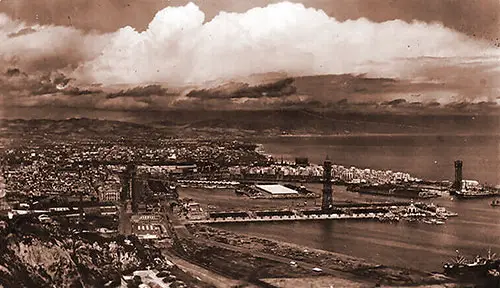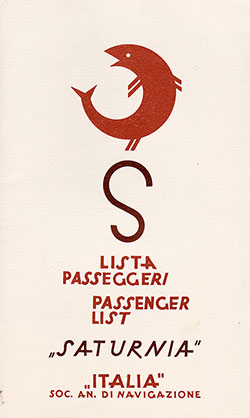Barcelona Passenger Lists 1952

Port and Harbor of Barcelona circa 1930. GGA Image ID # 170cb30a17
Passenger Lists available from the GG Archives from the Port of Barcelona, Spain. Organized by Date of Departure, Steamship Line, Steamship or Ocean Liner, Class of Passengers, Route, and the Ship's Captain.
The Port of Barcelona has a 2000-year history and great contemporary commercial importance as one of Europe's major ports in the Mediterranean, as well as being Catalonia's largest port, tying with Tarragona. The GG Archives has only a few passenger lists for this port.

1952-03-11 SS Saturnia Passenger List
- Steamship Line: Italia Soc. An. Di Navigazione
- Class of Passengers: Cabin Class
- Date of Departure: 11 March 1952
- Route: New York to Naples via Gibraltar, Barcelona, and Genoa
- Commander: Commanded by Captain Piero Calamai.

1952-03-30 SS Conte Grande Passenger List
- Steamship Line: Italia Line
- Class of Passengers: First Class
- Date of Departure: 30 March 1952
- Route: Genoa to Buenos Aires via Villefranche, Barcelona, Dakar, Rio de Janeiro, Santos, and Montevideo
- Commander: Captain Pietro Passano.

1952-05-22 SS Giulio Cesare Passenger List
- Steamship Line: Italia Line
- Class of Passengers: Second Class
- Date of Departure: 22 May 1952
- Route: Buenos Aires to Genoa via Barcelona and Villafranca
- Commander: Captain Filippo Rando.
Barcelona, formerly the capital of the kingdom of Catalonia, and now the chief town of the Spanish province to which it gives its name, is a flourishing city and seaport on the shore of the Mediterranean, in lat. 41° 22' N. and long. 2° 9' L between the rivers Béaoa (Brrlulo) on the north and the Llobrcgat ( Rubricate) on the south. It stands on the sloping edge of a small but fertile plain now covered with villas and gardens.
Immediately to the southeast rise the Montjuich hills to the height of 650 feet, crowned by on important fortification; while on the west, the north, and the north tut, the view is bounded by the heights of San Pedro Martio, Valcanca, and Muncada. Barcelona was formerly surrounded by a strong line of ramparts, and defended, or more correctly, overawed by a citadel on the north-east, erected in 1716 by Philip V. on Vauban’s principle; but these fortifications being felt as a painful restriction on the natural development of the city, were, in spite of the opposition of the central Government, finally abolished by the local authorities in 1845.
The waits of the moat were utilized for the cellars of the houses which soon occupied the site of the ramparts, and the ground, which had been covered by the ci tail el, was laid out in horticultural gardens. A rapid extension of the city to the north-west took place, and in 1800 an elaborate plan for the laying out of new districts received the royal sanction. Barcelona thus comprises an old and a new town, differing from each other in many important features, the former still consisting for the most part of irregular and narrow streets, while the latter has all the symmetry and precision of a premeditated scheme.
It carries on a large shipping trade. In 1872 between 700 and 800 foreign vessels, with a tonnage of 300,000 tons, discharged their cargoes in the port. Of these 100 were British. The imports from the colonies are sugar, cotton, tobacco, rum, wax, dye-wood, Ac. ; machinery, coals, coke, cotton, wool, thread, and other stuffs, are brought from England ; articles of silk, chemical preparations, pastes and flours of all sorts, objects of fashion, wines, and liquors, from France; petroleum, cotton, and staves from North America; cotton from the Brazils and Smyrna; hides from the River Plate; salt-fall from the North Sea. The export trade is not so extensive, consisting largely of fruits and vegetables, oil, silk, wines, salt, etc.
